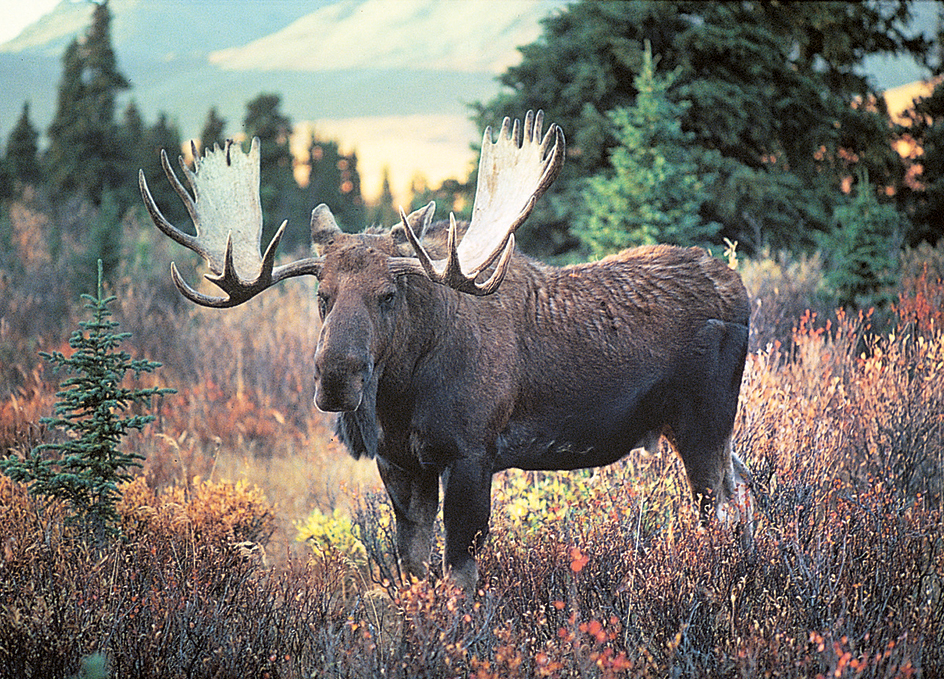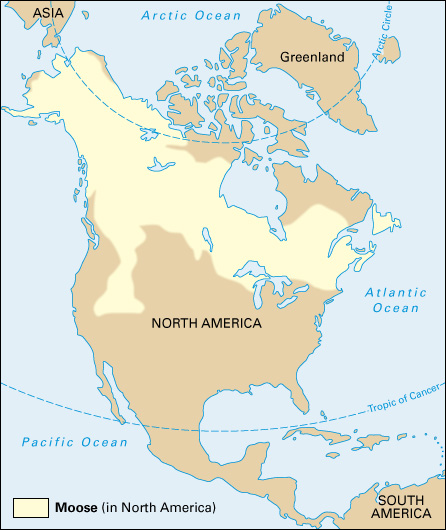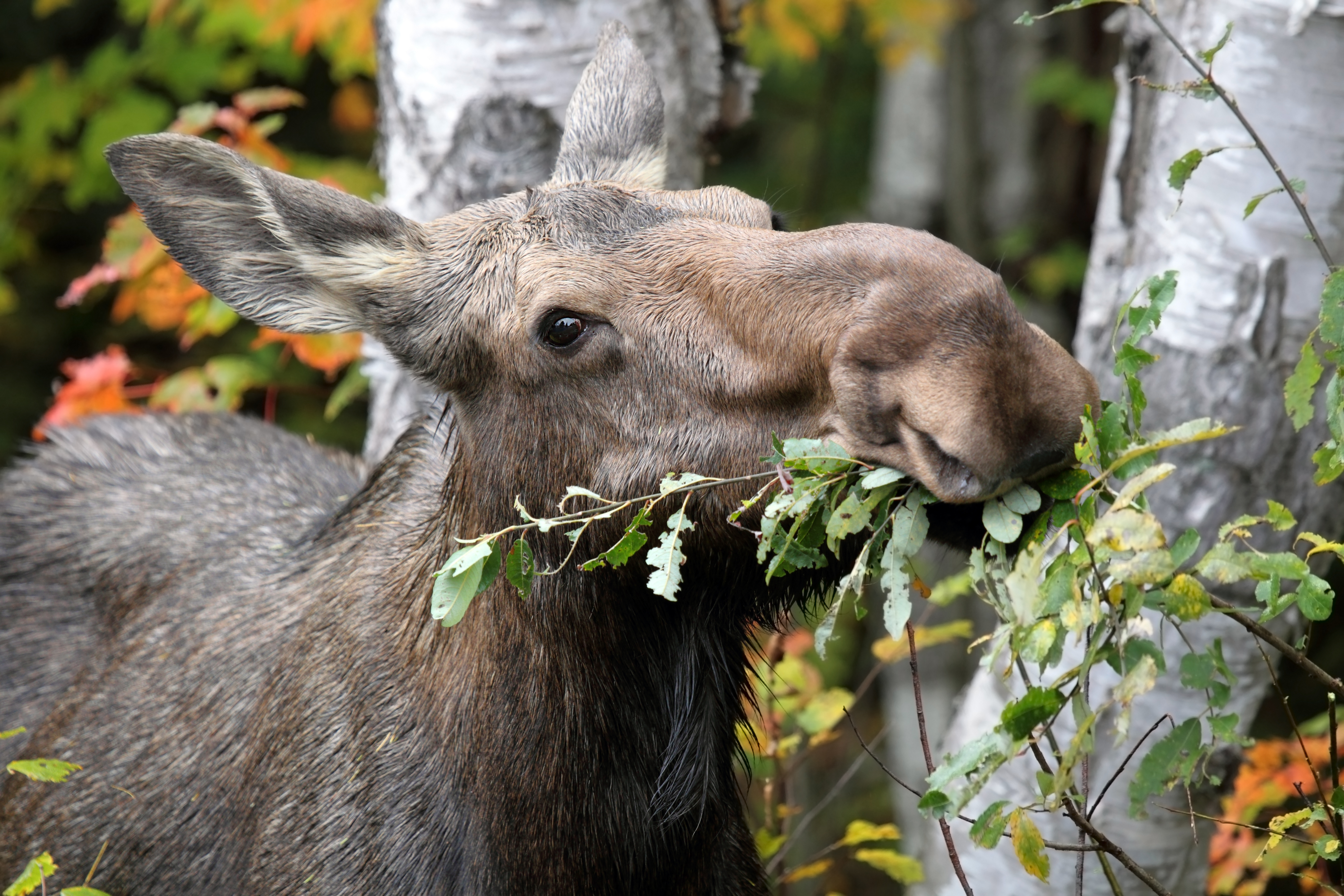Moose is the largest member of the deer family. The largest kind of moose lives in Alaska. It stands up to 7 1/2 feet (2.3 meters) high at the shoulder and weighs as much as 1,800 pounds (816 kilograms). Most moose stand about 6 1/2 feet (2 meters) high at the shoulder and weigh 800 to 1,400 pounds (360 to 640 kilograms).

Moose inhabit northern forests throughout the world. In Europe, they are known as elk and live in northern Scandinavia and eastward through Siberia. In North America, moose live in Canada and Alaska and southward into the Rocky Mountains to Utah and Colorado. They also live in parts of Maine, Michigan, Minnesota, New Hampshire, and North Dakota.
The body of a moose.
A moose has big shoulders that form a hump. Its long legs and broad hoofs make the moose a strong swimmer and help it walk in marshy areas and through deep snow. Moose fur is brownish-black on the upper parts, and grayish-brown on the belly and lower legs. A flap of skin and fur, called a bell, hangs from the moose’s throat.
The male moose, called a bull, has antlers. Moose antlers are shaped like the palm of a hand with many short, pointed fingers. Bulls shed their antlers every winter and then begin to grow new ones in spring. A pair of moose antlers may measure 5 to 6 feet (1.5 to 1.8 meters) wide and weigh as much as 85 pounds (39 kilograms).

The life of a moose.
The moose’s mating season lasts a few weeks in the fall. A bull will roam about in search of a female moose, called a cow. Both bulls and cows make calling sounds in the mating season, and a bull will move toward a calling cow. If a bull finds another bull with a cow, the bulls fight with their antlers to see which one will mate with her. A mature bull may mate with several cows in one mating season. Moose calves are born in the spring. A cow has one, two, or, rarely, three calves. A calf’s fur is reddish-brown. A calf stays with its mother until she chases it away the next spring before giving birth to her next calf.
Moose eat woody plants, especially twigs of willows and such shrubs as hazel, dogwood, and mountain maple. In addition, moose eat plants that grow under the surface of shallow water. They wade into streams and ponds and put their heads underwater to get a mouthful of plants. They raise their heads to watch for enemies while they chew.
Loading the player...Moose eating leaves
Moose usually live alone and do not form herds as do North American elk and caribou. However, sometimes a group of three or four moose will stay in one spot if the food there is plentiful.
The chief enemies of moose are bears and wolves. A wolf pack or a bear will kill and eat a calf if the calf can be separated from its mother. Once a moose is full-grown, even a wolf pack cannot kill it unless it is old or weak. A moose does not begin to suffer from old age until it is about 12 years of age or more.

Although moose and white-tailed deer both live in forests and eat similar food, the two animals are usually not found together in great numbers. Deer carry a disease that rarely is fatal to them but often kills moose. A tiny worm causes this disease. The worm lives harmlessly on the surface of a deer’s brain or spinal cord. But in a moose, the worm burrows into the central nervous system and causes paralysis and, eventually, death.
Moose and people.
Before European settlers came to North America, the moose provided an important source of food for Native Americans. But settlers cut down forests where moose lived and hunted moose until the animals became scarce in some areas. People eventually placed restrictions on moose hunting and enabled some of the forests to regrow. In addition, new moose habitats developed in the Arctic. Today, moose have become numerous enough to allow controlled hunting in most of Canada and the northern United States.
During the Middle Ages, people in northern Europe sometimes used moose as beasts of burden. Eventually, people used reindeer instead of moose for this purpose. Moose have been well protected by law in European countries, but the animals’ numbers are gradually declining in Europe. Some moose still live in parts of eastern Europe and in the forests of Norway, Sweden, and northeastern Germany. Moose populations range eastward across Siberia, China’s Northeast, and Mongolia.
See also Elk.
